This post is part of an ongoing series featuring items from the newly acquired Santo Domingo collection.
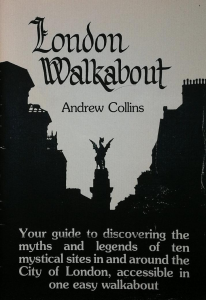 Although at first glance London Walkabout by Andrew Collins looks like a typical pamphlet for a tourist it actually is much more unusual. Subtitled “Your guide to discovering the myths and legends of ten mystical sties in and around the City of London, accessible in one easy walkabout,” this pamphlet promises a whole lot more than a standard tour. The ten sites include: the Tower of London, the London Stone, the Temple of Mithras, St. Paul’s Cathedral, Ludgate Hill, the Church of St. Martin’s-within-Ludgate, St. Bride’s Church Fleet St., the Church of St. Dunstan’s-in-the-West Fleet St., the Temple Church and St. Clement Danes Aldwych.
Although at first glance London Walkabout by Andrew Collins looks like a typical pamphlet for a tourist it actually is much more unusual. Subtitled “Your guide to discovering the myths and legends of ten mystical sties in and around the City of London, accessible in one easy walkabout,” this pamphlet promises a whole lot more than a standard tour. The ten sites include: the Tower of London, the London Stone, the Temple of Mithras, St. Paul’s Cathedral, Ludgate Hill, the Church of St. Martin’s-within-Ludgate, St. Bride’s Church Fleet St., the Church of St. Dunstan’s-in-the-West Fleet St., the Temple Church and St. Clement Danes Aldwych.
Each site has its own section which includes basic historical facts as well as myths and stories about the supernatural occurrences at the site. A list of famous ghosts at the Tower of London, an explanation of the Dianic Cult at St. Paul’s Cathedral and a section on psychic work at the Temple Church are some of the more intriguing stories told. Essentially arranged in a geographic line, Collin’s gives a walking guide that takes about 5 hours to complete and can be done entirely on one’s own. Details of what to look for at each site are included with the stories as well as pictures of each site for historical comparison and identification.

Andrew Collins, a prolific writer on the supernatural and occult, leads you through each site with unusual insights and history. Still an active writer today, he also does book tours and signings for his many mythological texts. Several of his books are available at Widener including Beneath the pyramids : Egypt’s greatest secret uncovered, The Cygnus mystery : unlocking the ancient secret of life’s origins in the cosmos and The knights of Danbury. London walkabout /by Andrew Collins, Wickford : Earthquest, 1984 (1986 [printing]) is also available at Widener Library.
Thanks to Emma Clement, Santo Domingo Library Assistant, for contributing this post.
Posted in Uncategorized | Comments Off on Myths of London
Nov 13th, 2014 by adharris
This post is part of an ongoing series featuring items from the newly acquired Julio Mario Santo Domingo Collection.

Death. Typically depicted as a skeleton with a sickel, one might suppose that if this card appeared in a tarot reading that you should prepare for an untimely demise, but it rarely signifies a physical death. Tarot card readings are a highly subjective topic depending on what you believe, but according to A.E. Waite, a recognized authority on the occult and tarot, the Death card usually means an end to a cycle or a transition into a new stage in your life.
Le Taro sacerdotal : reconstitué d’après l’astral et expliqué pour ceux qui savent déja published in 1951 consists of 22 beautiful lithograph cards, most of which are hand-colored with watercolors. The cards consist of an iconographic image with a corresponding description of the archetype below it, one of the exceptions being Death.
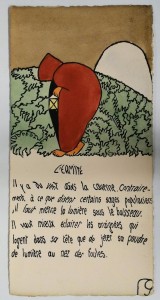
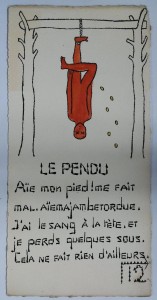
You can see that the style of the description scripts vary according to the image. Again according to Waite the Hermit represents guidance, introspection, solitude, and seclusion. The Hanged Man is based on a pittura infamante, a shameful image of a traitor being punished in a manner common at the time in Italy. Waite suggests the Hanged Man is associated with sacrifice, passivity, contemplation, and inner harmony.
The illustrator of these cards, Lucien Laforge, is also known for his illustrative work in magazines including  La Charrette : “Charrie” Aujourd’hui which was a short lived serial publication in 20th-century France. Courtesy of the JMSD collection we have the very last issue no. 24 in Widener and it is possible we may uncover more as we continue to catalog.
La Charrette : “Charrie” Aujourd’hui which was a short lived serial publication in 20th-century France. Courtesy of the JMSD collection we have the very last issue no. 24 in Widener and it is possible we may uncover more as we continue to catalog.
Hoping to find more information about Laforge I discovered the Database of Modern Tarot Art. Adam MacLean, who is an enthusiast for alchemical texts and symbolism, is creating a database from his own collection of tarot decks. They are currently sorted by geographic regions though there is also a keyword search function. The description of the entries vary depending on the information MacLean has on the specific deck, but it is a pretty robust database with at least two images from the deck for each entry.

Le Taro sacerdotal : reconstitué d’après l’astral et expliqué pour ceux qui savent déja / Lucien Laforge [and] André Godin : prints, 1951. MS Fr 606 can be found at the Houghton Library.
Thanks to Alison Harris, Santo Domingo Project Manager and Susan Wyssen, Manuscript Cataloger, for contributing this post.
Posted in Houghton Library | Comments Off on Shall I read your future?
Nov 11th, 2014 by houghtonmodern
This post is part of an ongoing series featuring items from the Julio Mario Santo Domingo Collection.
The Santo Domingo Collection continues to bolster Harvard’s library of works by author and occult leader Aleister Crowley. These range from substantive books on magic to pamphlets containing individual poems (one of these, titled “Tyrol”, is a condemnation of Mussolini for his 1929 prohibition of that name as part of his Italianization of the region). Crowley’s grandiose, egotistical mode is in evidence throughout, but so is his sardonic sense of humor. That humor is emblemized in his dedications, forewords, and other front matter, at turns combative, boastful, and wryly self-effacing. Two examples appear in this post. The first appears in The sword of song, called by Christians the book of the Beast. This was Crowley’s first publication in which he referred to himself as “the Beast”, in defiance of his critics, and according to Crowley, was impeded by boycotts from British publishers. (The publisher on the imprint is the Society for Religious Truth, Benares, although subsequent Society publications would give Inverness as their location.) The dedication roundly dismisses these opponents of Crowley’s poetic vision.
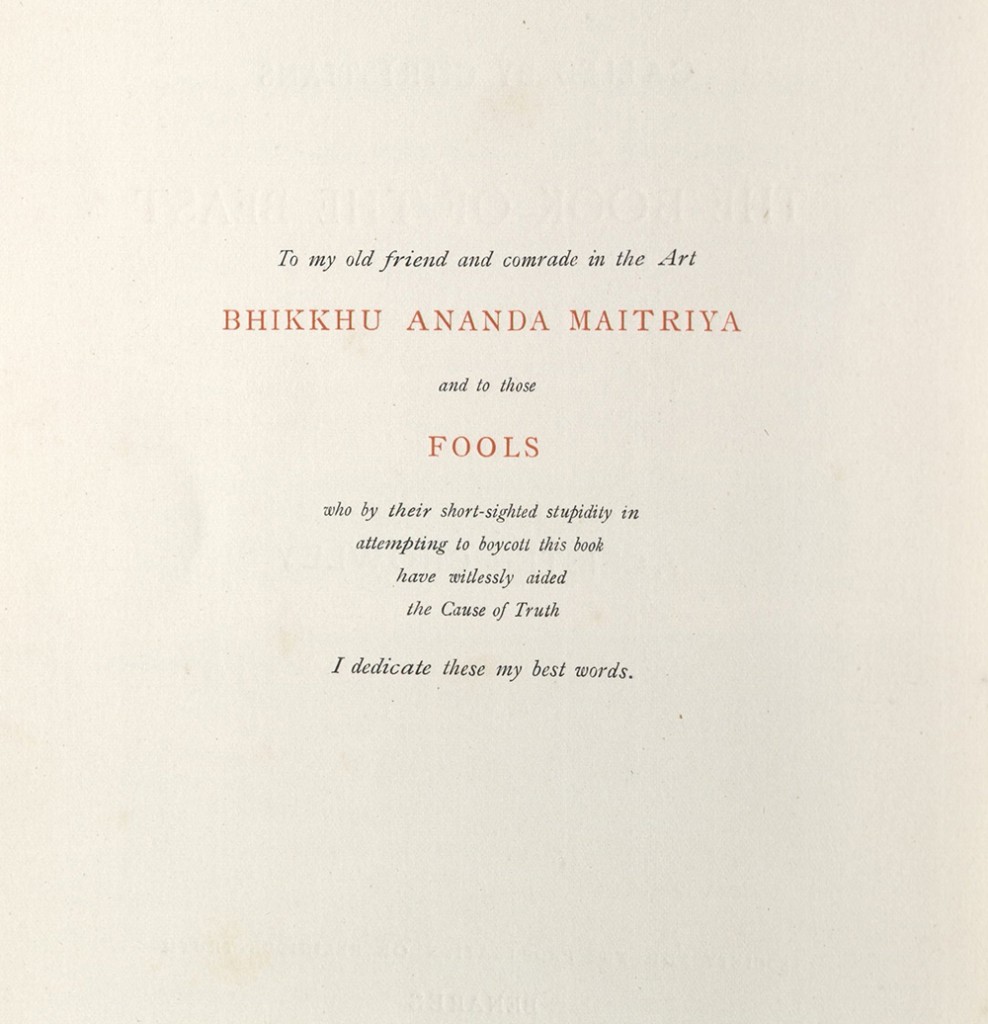
The second example is Ambergris, a selection of poetry. In its preface, Crowley outlines the selection process in a passage both self-deprecating and resentful, making reference to the public’s underappreciation of his work.
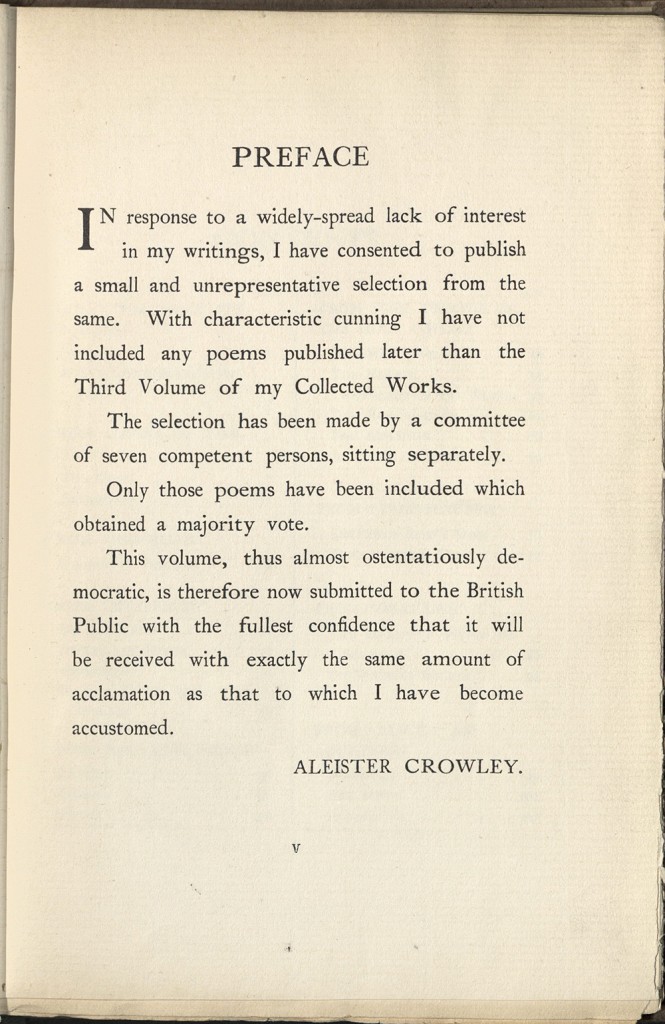
The sword of song: EC9.C8863.904s, HOLLIS number 14166213
Ambergris: EC9.C8863.910a, HOLLIS number 2915207
Thanks to rare book cataloger Ryan Wheeler for contributing this post.
Posted in Houghton Library | Comments Off on Crowley and the Beast
This post is part of an ongoing series featuring items from the newly acquired Santo Domingo collection.
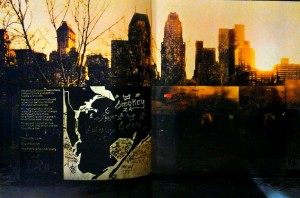 The Faith of Graffiti presents the reader with beautiful full-spread photographs of street art by Jon Naar and Mervyn Kurlansky with an accompanying text by Norman Mailer. By keeping the text separate in the center of the book, the reader is able to fully immerse himself in the photographs and experience the depth of street art as an exhibit. Mailer’s description of the art and history of graffiti draws the reader in further with anecdotes and stories about the great street artists. The definitive book on graffiti and street art in their early incarnation in the 1970s, this book is sure to interest aficionados as well as those just browsing the topic.
The Faith of Graffiti presents the reader with beautiful full-spread photographs of street art by Jon Naar and Mervyn Kurlansky with an accompanying text by Norman Mailer. By keeping the text separate in the center of the book, the reader is able to fully immerse himself in the photographs and experience the depth of street art as an exhibit. Mailer’s description of the art and history of graffiti draws the reader in further with anecdotes and stories about the great street artists. The definitive book on graffiti and street art in their early incarnation in the 1970s, this book is sure to interest aficionados as well as those just browsing the topic.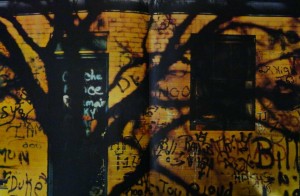
Norman Mailer, a novelist and Pulitzer Prize winning journalist, pens the essay portion of this book, delving deep into the history of street art and its cultural importance. The essay is art in itself, pairing more traditional forms of art with stories of graffiti artists to weave a narrative about the impact of this new art form. 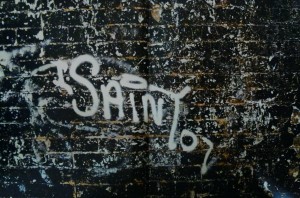 Joined by photographers Mervyn Kurlansky and Jon Naar, with their images of hundreds of examples of street art around New York City, The Faith of Graffiti is an intriguing and thorough experience. Their eye for photography allows the reader to understand both the intricacies of graffiti as well as the environment it lives in by taking large scale landscape photos and juxtaposing them with detailed close ups.
Joined by photographers Mervyn Kurlansky and Jon Naar, with their images of hundreds of examples of street art around New York City, The Faith of Graffiti is an intriguing and thorough experience. Their eye for photography allows the reader to understand both the intricacies of graffiti as well as the environment it lives in by taking large scale landscape photos and juxtaposing them with detailed close ups.
A first edition copy signed by all three authors is available in the Julio Mario Santo Domingo Collection at Widener Library. The faith of graffiti. Documented by Mervyn Kurlansky and Jon Naar. Text by Norman Mailer. New York, Praeger [1974]
Thanks to Emma Clement, Santo Domingo Library Assistant, for contributing this post.
Posted in Uncategorized | Comments Off on Street Art in the 1970s
Oct 30th, 2014 by adharris
This post is part of an ongoing series featuring items from the newly acquired Julio Mario Santo Domingo Collection.

In honor of Halloween I thought we share some creepy images that we found recently in a copy of Vu, a French periodical that covers a range of topics concerning France in the early 20th-century. As the cover attests this issue deals with mysteries and miracles from 1931. We have a depiction of a man performing magnetism, 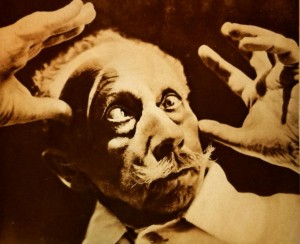 a photograph of a healer that accompanies an article about sorcery, witches, and the occult.
a photograph of a healer that accompanies an article about sorcery, witches, and the occult. 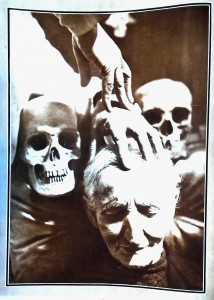
And even a spooky cinematic scene. 
Happy Halloween!
Vu. Paris : Société anonyme “Les illustrés franc̜ais”1928-1940? can be found in Widener’s Collection.
Thanks to Alison Harris, Santo Domingo Project Manager for contributing this post.
Posted in Widener Library | Comments Off on Spooktacular!
Oct 28th, 2014 by houghtonmodern
This post is part of an ongoing series featuring items from the Julio Mario Santo Domingo Collection.
Though outnumbered by books on drugs and sexuality, the Santo Domingo Collection’s occult works are nonetheless considerable in number. Featured today are two early works on demonology, one by a French political philosopher and statesman, and the other by an Italian Franciscan priest.
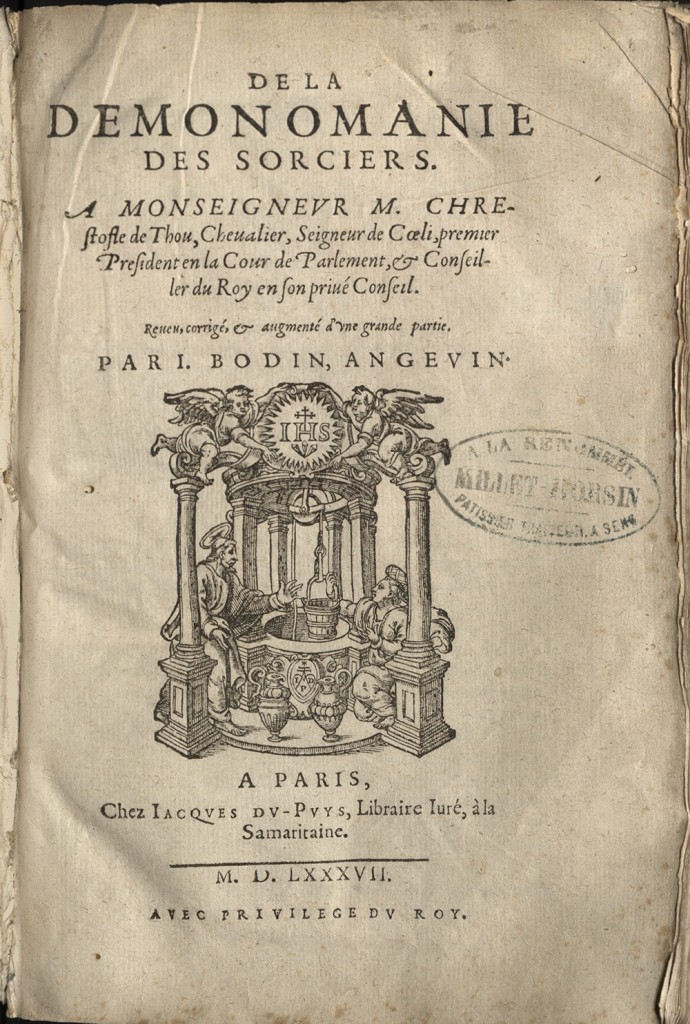
Jean Bodin (1530-1596) espoused a number of unconventional views regarding religion and the state: he opposed papal influence over government, and was an early proponent of religious tolerance. On the topic of witchcraft, however, he was less forgiving. De la démonomanie des sorciers was first published in 1580; pictured here is a 1587 revision, one of ten that were printed between 1580 and 1604. In it, Bodin discusses broad concepts such as deals with the devil and the sabbat, as well as histories of individual sorcerers. He further describes at length his recommendations for legal procedure against accused sorcerers. At the time, the Parlement of Paris required one of three forms of evidence in order to proceed to interrogation: tangible evidence such as a written pact with the devil; a confession made freely (which is to say, not under torture); or witness testimony confirming an act of sorcery. Bodin felt that these rules were too strict, and that too many sorcerers were escaping execution: in the Démonomanie , he advocates that these rules be relaxed, under the belief that rumors of sorcery nearly always prove true.
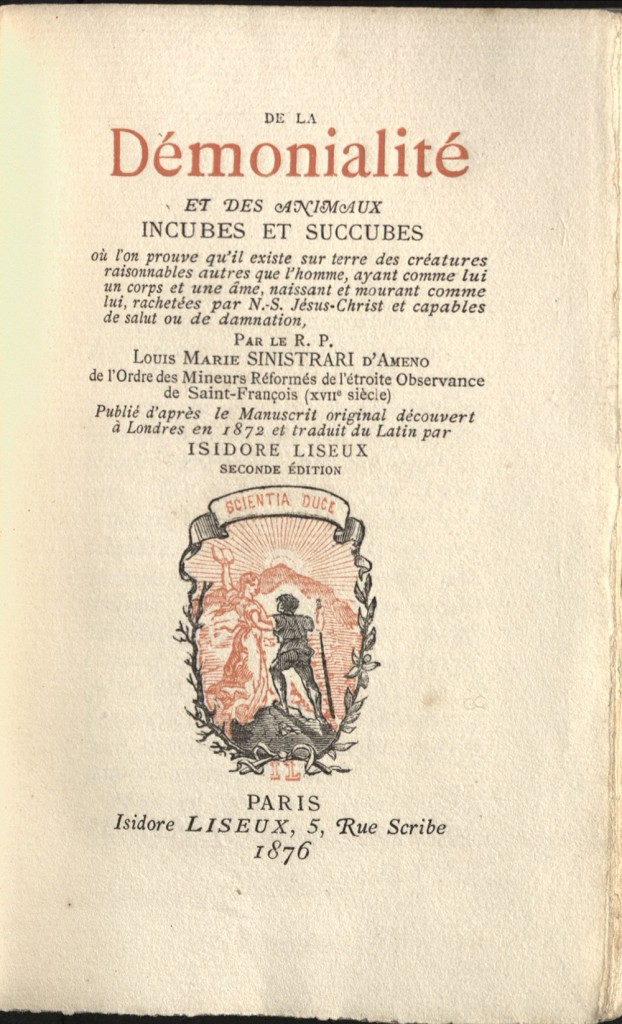
Our second book is by Ludovico Maria Sinistrari (1622-1701), a priest and advisor to the Roman Inquisition. Sinistrari was an influential thinker on sexual sin; he authored works on homosexuality and sodomy. De daemonalitate et incubis et succubis, the work pictured here, did not see print in Sinistrari’s lifetime; the first publication of this 1680 manuscript was in Paris in 1875, with a French translation alongside the original Latin. (Houghton Library’s copy is of the second edition, from the following year.) It treats of demons and their exorcism, and particularly of incubi and succubi. In Sinistrari’s view, these beings are driven not by demonic motivation but by carnal desire; they also possess the human quality of self-reflection, and are somewhere between humans and true devils. Sinistrari posits that intercourse between an incubus and a human woman produces an unnatural, hybridized being; among his condemnations of Martin Luther is his accusation that Luther was the spawn of a devil. De daemonalitate, then, is an extended reflection on how the otherworldly and the erotic interact; the sexuality of demons is among the many links that interrelate Santo Domingo’s major collecting areas.
Jean Bodin. De la démonomanie des sorciers. Paris: Chez Iacques dv-Puys … , 1587. FC5.B6324.580df (B).
Ludovico Maria Sinistrari. De la démonialité et des animaux incubes et succubes. Paris: Isidore Liseux, 1876. BF1556.S5 1876.
Thanks to rare book cataloger Ryan Wheeler for contributing this post.
Posted in Houghton Library | Comments Off on Demons and devils
Oct 23rd, 2014 by houghtonmodern
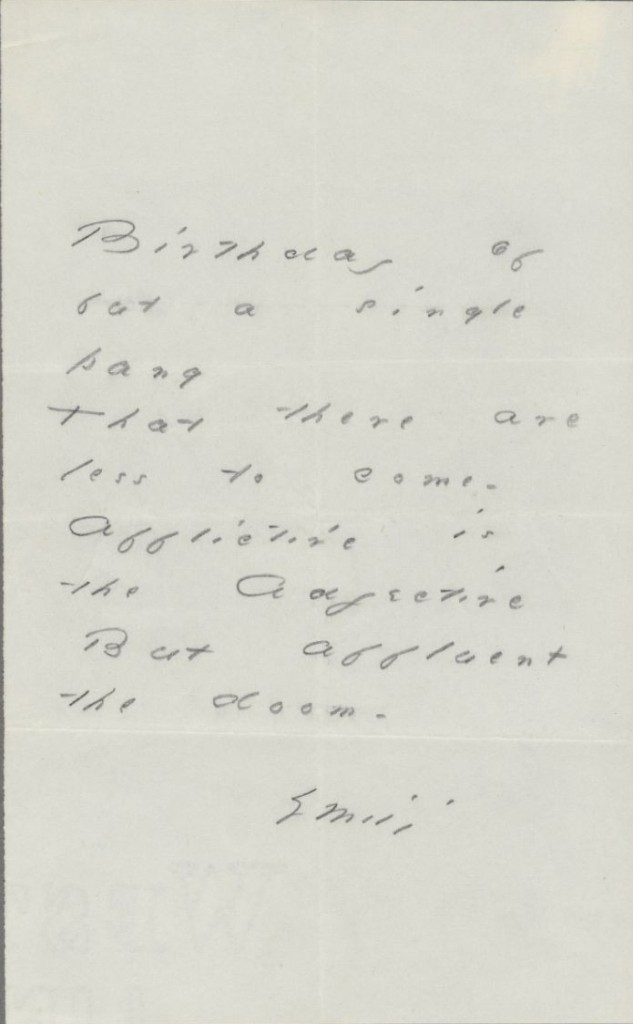
Launched on October 23, 2013, the Emily Dickinson Archive (EDA) celebrates its first year of operation today, during Open Access Week.
The site received 1.2 million “hits” from poetry lovers in its first 10 days; after a year, monthly usage averages 10,000 visits and 377,000 page views per month. About 80% of visitors are from English-speaking countries, with the rest coming from Italy, the Philippines, Saudi Arabia, Japan, China, India, Sudan, Pakistan, and other countries world-wide.
Favorite poems vary from month to month, driven by use of EDA in secondary schools as well as college and university courses. But some poems appear frequently: “Because I could not stop for Death“; “My Life had stood a Loaded Gun”; “I’m Nobody! Who are you?“; ” ‘Hope’ is the thing with feathers–“; “I dwell in Possibility–“; and “The Soul selects her own Society–“.
Houghton Library collaborated with the American Antiquarian Society, Amherst College, Boston Public Library, the Library of Congress, Smith College, Vassar College and Beinecke Library, Yale University, on this first release of the site. Since then, images have been contributed by Dumbarton Oaks (a manuscript believed lost); Morgan Library & Museum, New York Public Library (Berg Collection and Manuscripts and Archives), and The Rosenbach of the Free Library of Philadelphia. More images are in the works, and these will be added in a second release, scheduled for early 2015.
Image above: Emily Dickinson to Susan Huntington Dickinson, [December 1880] Pencil; 1p. Begins: Birthday of but a single pang… Sent to Susan Dickinson on her 19th birthday. JL 679, J 1488, Fr 1541. Houghton Library MS Am 1118.5 (B155).
Posted in Houghton Library | Comments Off on Happy Birthday, Emily Dickinson Archive!
This post is part of an ongoing series featuring items from the newly acquired Santo Domingo collection.
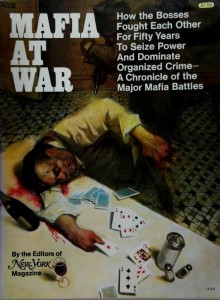 Detailing the early 1970s mob scene Mafia at War is an interesting and thorough read. Published by New York Magazine, this book gives an in depth chronology of the mob bosses from the early 1900s to the early 1970s. Split into time segments with a focus on who was the current boss at the time, one can follow the violence and death that surrounds the mob. Mafia at War takes a decidedly negative view of gang warfare, specifically calling out the misconception that mobsters only kill other mobsters. Presented as a historical overview of mob warfare, this book includes everything from photographs of mafia members to crime scene photos, to beautiful paintings of famous mob hits. Also included in the back are maps of which mafia holds jurisdiction in each New York City borough as well as in the continental United States.
Detailing the early 1970s mob scene Mafia at War is an interesting and thorough read. Published by New York Magazine, this book gives an in depth chronology of the mob bosses from the early 1900s to the early 1970s. Split into time segments with a focus on who was the current boss at the time, one can follow the violence and death that surrounds the mob. Mafia at War takes a decidedly negative view of gang warfare, specifically calling out the misconception that mobsters only kill other mobsters. Presented as a historical overview of mob warfare, this book includes everything from photographs of mafia members to crime scene photos, to beautiful paintings of famous mob hits. Also included in the back are maps of which mafia holds jurisdiction in each New York City borough as well as in the continental United States.
One of the most interesting sections of this publication is the artists’ depictions of famous mob murders. A collection of images by painters and illustrators active in New York City at the time, Mafia at War features such artists as Harvey Dinnerstein, James McMullan and Paul Davis. Each image is accompanied by a story about the murder and the background of the mob boss involved. 
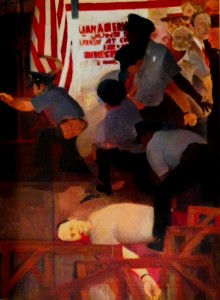
The Mafia at war, by Thomas Plate and the editors of New York magazine. With contributions by Nicholas Pileggi [and others] New York New York Magazine Press 1972 is available in Widener Library Collection.
Thanks to Emma Clement, Santo Domingo Library Assistant, for contributing this post.
Posted in Uncategorized | Comments Off on Mob Stories
Oct 16th, 2014 by adharris
This post is part of an ongoing series featuring items from the newly acquired Julio Mario Santo Domingo Collection.
Francois Villon was all of those things, and most prominently a subversive outsider. At a time when most poetic works were strongly religious or allegorical Villon wrote with honesty about love and sex, drinking, money problems, and living on the road in 15th-century France. Many of his works were meant to be read aloud, preferably in a tavern. He is known to have influenced modern English poetry, particularly Ezra Pound. This limited edition of Villon’s works and accompanying illustrations by Albert Dubout was published in France around 1933.

The text above is taken from Villon’s poem Bequests, whose premise is that Villon is leaving the city after being spurned by a woman, so he must leave all of his possessions behind. He details a long list of beneficiaries gifting them with worthless junk and items that he never owned, essentially mocking everyone and everything. Most of Villon’s poems have a strong dose of social satire and a tone of merry pranksterism.
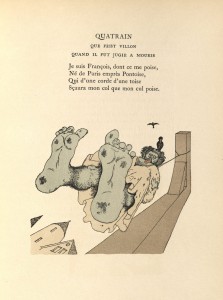
This shorter poem translates to:
I am Francois, which I find a burden,
born in Paris (near Pontoise),
and from the six-foot rope
my neck will learn what my ass weighs.
This poem could be read as a direct commentary of Villon’s life since he was indeed condemned to death in November of 1462. The story goes that he was involved in a brawl where the Pope’s Paris notary was stabbed by a companion so he was sentenced to hang since he had already been jailed three times. However, Villon appealed the case and his sentence was changed to a 10 year banishment from Paris. Villon celebrated by writing both a poem taunting the prison clerk and then another lavishly praising the court. Shortly thereafter he disappeared from public view.
Though it is tempting to look at Villon’s work as completely biographical many scholars contend that he created a mix of factual and fictional information to create this character of Villon featured in his works. To see more illustrations by Dubout or recite some of Villon’s verse in French you can find this volume at Houghton Library. Villon (oeuvres) /illustrations de Dubout.Oeuvres. Paris : Gibert Jeune, Librairie d’Amateurs, [1933]. FC.V7195.B933v
Thanks to Alison Harris, Santo Domingo Project Manager and Ryan Wheeler, Rare Book Cataloger, for contributing this post.
Posted in Houghton Library | Comments Off on A poet, killer, thief, brawler, and vagabond….
This post is part of an ongoing series featuring items from the newly acquired Santo Domingo collection.
 James Wasserman, author, editor, publisher and occultist, gives us Art and Symbols of the Occult. A disciple of Aleister Crawley’s Ordo Templi Orientis, he has written numerous books on the subject as well as republishing and updating several of Crawley’s works including photographing the Tarot cards from the Thoth Tarot deck. Wasserman got his literary start at Weiser Books, one of the largest bookstores and publishers in occult literature. He subsequently founded Studio 31 which offers book production and graphic design and has continued to focus in occult literature. Wasserman also founded one of Ordo Templi Orientis’s oldest lodges in New York City in 1979.
James Wasserman, author, editor, publisher and occultist, gives us Art and Symbols of the Occult. A disciple of Aleister Crawley’s Ordo Templi Orientis, he has written numerous books on the subject as well as republishing and updating several of Crawley’s works including photographing the Tarot cards from the Thoth Tarot deck. Wasserman got his literary start at Weiser Books, one of the largest bookstores and publishers in occult literature. He subsequently founded Studio 31 which offers book production and graphic design and has continued to focus in occult literature. Wasserman also founded one of Ordo Templi Orientis’s oldest lodges in New York City in 1979.
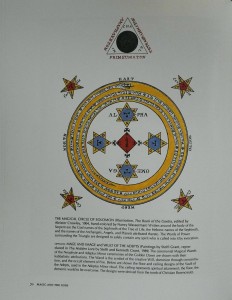
Art and Symbols of the Occult explores both typical symbols of the occult such as the Golden Dawn Cross and masonic art, as well as more classic and religious art such as St. George and the Dragon by Raphael and The temptation of St. Anthony by Hieronymus Bosch. Wasserman covers a wide variety of pieces, ranging from ancient Egyptian art, to the monument at Stonehenge to kabbalah texts.
 Split into several sections on different facets of the occult, Wasserman prefaces each chapter with a discussion of the practice and then offers pages and pages of art he assigns to the categories. Each image is accompanied by a short blurb about historical context and meaning, an easy enough read for those not versed in art history or the occult.
Split into several sections on different facets of the occult, Wasserman prefaces each chapter with a discussion of the practice and then offers pages and pages of art he assigns to the categories. Each image is accompanied by a short blurb about historical context and meaning, an easy enough read for those not versed in art history or the occult.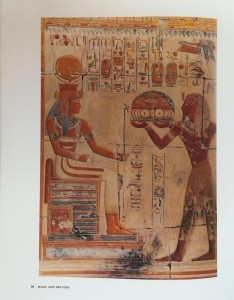
Art and Symbols of the Occult , Wasserman’s first book, was expanded and rereleased in 2005 as The Mystery Traditions: Secret Symbols and Sacred Art. The original version Art and Symbols of the Occult / London : Tiger Books International, c1993. can be found in Widener Library’s collection.
Thanks to Emma Clement, Santo Domingo Library Assistant, for contributing this post.
Posted in Uncategorized | 1 Comment »
Oct 2nd, 2014 by adharris
This post is part of an ongoing series featuring items from the newly acquired Julio Mario Santo Domingo Collection.
We are lucky to have found three first editions of Traité du chanvre in different bindings as we continue to unpack and catalog items from Santo Domingo boxes. From left to right the images reflect the covers of these copies at Houghton, Countway, and Botany.


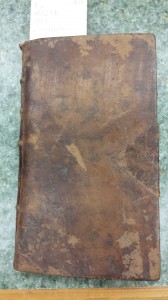
Traité du chanvre was published in 1758 in Paris and is a treatise about hemp. Written by M. Marcandier, who was a magistrate from Bourges, a city in central France, he wrote about hemp’s history, preparation, uses, and about new methods of cultivation and manufacture. There is a translated version in English which was published a few years later in 1764 and can be found online.
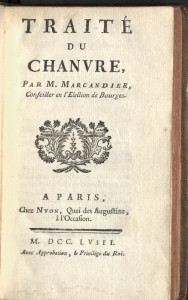
The range of bindings on these volumes is just as interesting as the content within it. Houghton’s copy was in the best shape bound in contemporary mottled calf with the edges stained red in addition to having having beautiful marbled end papers.
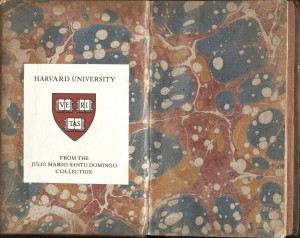
Botany’s volume is similar to Houghton’s though its leather was in much poorer shape. Though it lacked the marbled end papers, this copy has a decorated spine.

Countway’s volume was the most different as it wasn’t bound in leather at all, but in contemporary decorated paper wrappers featuring some sort of purple stamp design. Presumably at some point a custom box was made for it mimicking the original design with purple dots decorating the box housing.
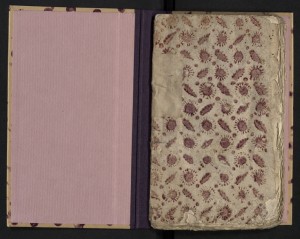
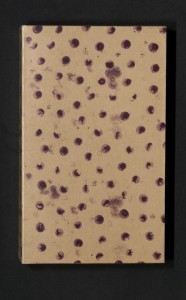
To look at any of these volumes of Traité du chanvre /par M. Marcandier. A Paris :Chez [J.L.] Nyon, Quai des Augustins, à l’Occasion,MDCCLVIII [1758] from the libraries mentioned above look in the Hollis catalog.
Thanks to Alison Harris- Santo Domingo Project Manager, Ryan Wheeler- Rare Book Cataloger at Houghton, Joan Thomas- Rare Book Cataloger at Countway, and Chris Robson of the Botany Libraries for contributing to this post.
Posted in Countway Library, Harvard Medical School, Harvard Botany Libraries, Houghton Library | Comments Off on Three times as nice
This post is part of an ongoing series featuring items from the newly acquired Santo Domingo collection.
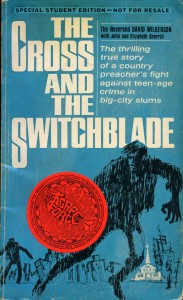 Several books by the Reverend David Wilkerson and his followers are in the Santo Domingo Collection. Wilkerson, an evangelic pastor who moved to New York because he felt called to help young gang members and drug addicts, recounts his success stories in books like The Cross and the Switchblade and Hey, Preach…You’re coming through. Also included in the collection are books by Nicky Cruz, one of Wilkerson’s greatest success stories, like Run Baby Run an autobiographical account of his gang life and recovery.
Several books by the Reverend David Wilkerson and his followers are in the Santo Domingo Collection. Wilkerson, an evangelic pastor who moved to New York because he felt called to help young gang members and drug addicts, recounts his success stories in books like The Cross and the Switchblade and Hey, Preach…You’re coming through. Also included in the collection are books by Nicky Cruz, one of Wilkerson’s greatest success stories, like Run Baby Run an autobiographical account of his gang life and recovery.

Wilkerson, born into a religious family, devoted his life to the church and began preaching at a very young age. After hearing about young men on trial for gang related offenses, he went to New York, ran into the courtroom and tried, unsuccessfully, to disrupt the trial. Not to be discouraged, he later founded the recovery group Teen Challenge to work with teen addicts and gang members. Wilkerson also founded the Time Square Church; a nondenominational ministry where he preached personal connection with Jesus and God. The Cross and the Switchblade, Wilkerson’s first book was a national best seller and was eventually turned into a movie starring Pat Boone and Erik Estrada.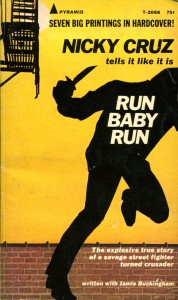
These books, with graphic and eye catching covers, seem to be marketed as thrilling stories for general consumption and not marketed for church and religious groups specifically. Showing both the dark side of addiction and violence, as well as the ultimate salvation of the church, the books weave impressive and gripping tales. The Cross and the Switchblade, Hey, Preach…You’re coming through, and Get your hands off my throat by Wilkerson can be found in the Widener Library collection. Run Baby Run and The Lonely Now by Cruz are also available.
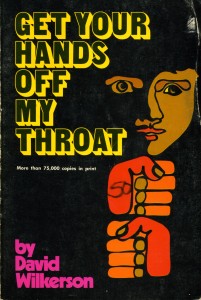
Thanks to Emma Clement, Santo Domingo Library Assistant, for contributing this post.
Posted in Uncategorized | Comments Off on The Best Selling Preacher
Sep 18th, 2014 by adharris
This post is part of an ongoing series featuring items from the newly acquired Julio Mario Santo Domingo Collection.
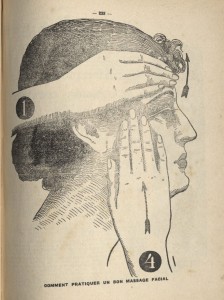

Before botox, plastic surgery, and aestheticians, L’horreur!, women were forced to combat aging and maintain beauty the old fashioned way- with tips and remedies from publications such as Comment se guérir? This French publication by the mysterious Dr. Druah loosely translates into How to Cure? and in addition to advice about common medical maladies it gives women all the latest advice and products for common beauty dilemmas. Including as we can see from the above images how to give a good facial massage.
Worried about a flushed or reddish face? The advice is that this condition stems from poor blood circulation and offers up various products to help. Infusing a cloth with elderflower and wearing it over ones’s face is one suggestion. Don’t worry ladies it looks totally normal!
 This volume was an edition of popular science works called “Edition de vulgarisation scientifique” and it was most likely published by a pharmaceutical company that sold some of these remedies.
This volume was an edition of popular science works called “Edition de vulgarisation scientifique” and it was most likely published by a pharmaceutical company that sold some of these remedies.
Comment se guérir? / par le docteur Druah. Paris : Institut “Paris-Londres”, [between 1890 and 1910?] RC81 .D79. can be found at the Countway Library at the Harvard Medical School in Longwood.
Thanks to Alison Harris, Santo Domingo Project Manager and Joan Thomas, Rare Book Cataloger at Countway for contributing this post.
Posted in Countway Library, Harvard Medical School | Comments Off on Before there was Botox
This post is part of an ongoing series featuring items from the newly acquired Santo Domingo collection.
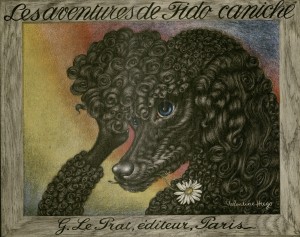 Le Aventures de Fido Caniche by surrealist artist Valentine Hugo, is an intricately detailed picture book that follows a dream sequence of Fido, an innocent, inquisitive poodle. In the dream Fido visits other exotic animals including a peacock and a lion, and at one point successfully imitates a lion to scare people and steal their food. However, when a rainstorm washes away his scary disguise the other forest animals mock him and he realizes he must return to his owner, Marguerite.
Le Aventures de Fido Caniche by surrealist artist Valentine Hugo, is an intricately detailed picture book that follows a dream sequence of Fido, an innocent, inquisitive poodle. In the dream Fido visits other exotic animals including a peacock and a lion, and at one point successfully imitates a lion to scare people and steal their food. However, when a rainstorm washes away his scary disguise the other forest animals mock him and he realizes he must return to his owner, Marguerite.
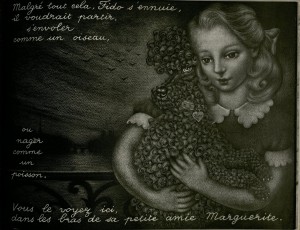
Valentine Hugo, a talented illustrator belonged to a famous circle of surrealists, at one point marrying Jean Hugo, but also was romantically involved with the surrealist Andre Breton. She was drawn to ballet and set design, though her work was not always successful. Her most long lasting artistic endeavor and partnership was with Paul Éluard. Her art was successful in her lifetime and she was in several surrealist exhibitions. There was also a posthumous retrospective of her work exhibited at Centre Culturel Thibaud de Champagne in 1977.

Houghton Library has several other works with Hugo’s illustrations including: Le phénix. Avec 18 dessins de Valentine Hugo by Paul Eluard, Médieuses : poèmes / de Paul Eluard ; illustrés par Valentine Hugo and Mouvements de danse de l’antiquité à nos jours / Valentine Gross. Also available at Houghton Library from the Julio Mario Santo Domingo Collection, is a book of family photos compiled by Valentine Hugo from her younger years: Photos de familles : photograph album, ca. 1907.
Le aventures de fido Caniche / Valentine Hugo : Paris : Guy Le Prat, c1947 is available at the Fine Arts Library.
Thanks to Emma Clement, Santo Domingo Library Assistant, for contributing this post.
Posted in Uncategorized | Comments Off on Adventures of Fido
Sep 4th, 2014 by adharris
This post is part of an ongoing series featuring items from the newly acquired Julio Mario Santo Domingo Collection.

Gerald Laing was an artist that was part of the British Pop movement in the 1960s and remains one of the most well-known today. His work in this period was typically a painting of a reproduced image often a drag racer, skydiver, astronaut, or starlet. One of his most famous pieces is a painting from a newspaper photograph of Brigitte Bardo, which sold at Christie’s in February 2014 for just under $1.5 million.

Laing was deeply influenced by the experiences of William Burroughs in the Amazonian rainforest in search of ‘Ayahuasca’ the hallucinogenic vine with the active ingredient Dimethyltriptamine (D.M.T.) This beautiful volume published in 1969 is a result of that influence, it is illustrated with 23 screenprints by Laing and the text was written by Galina Valentina Golikova. This deluxe edition of DMT 42 is no. 50 out of the 210 copies produced and each print is signed by Laing. It comes in a soft-cover book with silver wrappers that is housed in a claret corduroy case. The color screenprints throughout the volume are very indicative of Laing’s British Pop inclinations.
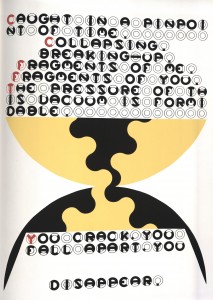
Golikova who wrote the text for DMT 42 was actually Laing’s second wife. He ended up doing a sculptural series on her entitled Galina I to X from 1973 to 1980. Laing states that he experienced an epiphany at Charles Sargeant Jagger’s great First World War Artillery Memorial at Hyde Park Corner in England, which led to the Galina Series. It marked a new method for Laing who had previously only worked with sheet metal but began sculpting in clay and then casting in bronze during this period.
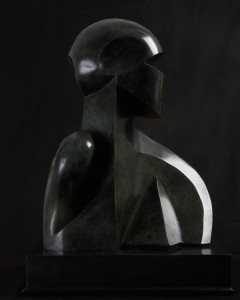
To see more examples of Laing’s work in DMT 42 /[text] by G. V. Golikova ; illuminated by Gerald Laing. [Deluxe edition] Stuttgart : Edition Domberger, [1969]. N7433.4.L35A4 1969bPF please visit the Fine Arts Library. We are lucky to also have another edition of DMT 42 in a different binding which can be located at the Fine Arts Library as well- N7433.4.L35 A4 1969 PF
Thanks to Alison Harris, Santo Domingo Project Manager for contributing this post.
Posted in Fine Arts Library | Comments Off on British pop art
Sep 2nd, 2014 by houghtonmodern
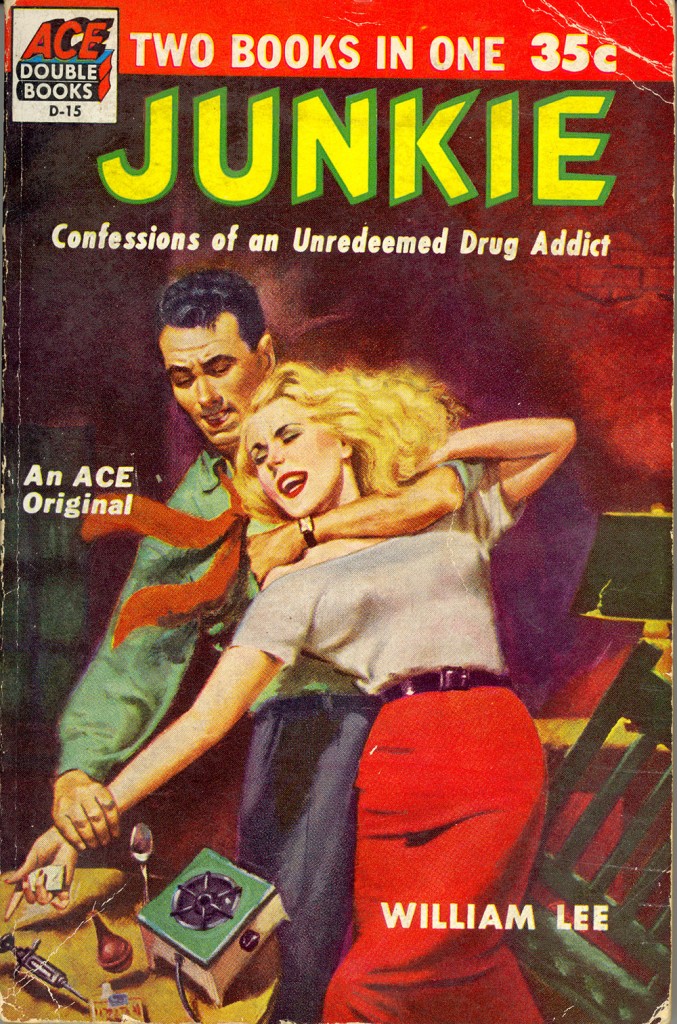 This post is part of an ongoing series featuring items from the Julio Mario Santo Domingo collection.
This post is part of an ongoing series featuring items from the Julio Mario Santo Domingo collection.
William S. Burroughs (1914-1997) looms large among countercultural figures of 20th-century literature. The seminal Naked lunch is a famous source of controversy – it was banned in Boston in 1962, and ultimately redeemed in a 1966 obscenity trial before the Massachusetts Supreme Judicial Court – but is only part of a much larger oeuvre of fiction, essays, and visual art. While Houghton Library already held a considerable Burroughs collection, the acquisition of the Santo Domingo Collection has expanded our holdings to include literary journal contributions, collaborative texts, and other works.
Continue Reading »
Posted in Houghton Library | Comments Off on Burroughs in pulp
Sep 1st, 2014 by houghtonmodern
This week’s post on Harvard College Library’s zines collection looks at Part Two of a publication entitled It’s a wonderful lifestyle: A seventies flashback published in 1993. In the words of author Candi Strecker, the publication is an “encyclopedic examination” of American popular culture in the 1970s, and judging by the range of topics covered – ‘70s products, lifestyles, crafts, sports, furniture, eating habit, appliances etc. – encyclopedic feels like the right adjective.
Continue Reading »
Posted in Houghton Library | Comments Off on Jogging, macramé and mug trees: A ‘70s flashback
This post is part of an ongoing series featuring items from the newly acquired Santo Domingo collection.

One very unique book by celebrated German-American artist Peter Max, Paper Airplane Book, showcases both his artistic talent as well as his playful attitude towards his work. Entirely consisting of templates for paper planes, each sporting bright colors and happy phrases, Paper Airplane Book is an exceptional take on a typical child’s toy.
An avid environmentalist, many of the slogans on his paper airplanes remind people not to litter and to take care of the earth. 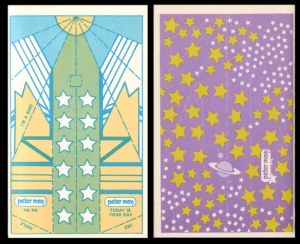
 Other optimistic phrases include “I can’t talk, cause I’m laughing” and “today is your day”. Max also promotes the creativity of the reader by giving them several uncolored templates to “Go wild with colors and way-out with slogans. Do your own thing!”
Other optimistic phrases include “I can’t talk, cause I’m laughing” and “today is your day”. Max also promotes the creativity of the reader by giving them several uncolored templates to “Go wild with colors and way-out with slogans. Do your own thing!”
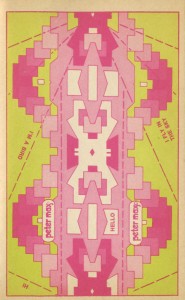
Peter Max, a graphic artist still active today, was inspired by the psychedelic colors of the 1960s and 1970s. Max’s work has found great commercial appeal; he has designed campaigns from everything from the World Cup and Super bowl to graphics to adorn commercial airplanes. Max’s art has the aesthetics of pop art and commercial illustration, and his subjects vary widely. Several more Peter Max books can be found in the Fine Arts Library Collection as well as Widener Library. Some titles are: Peter Max superposter book, The Peter Max land of red and The universe of Peter Max.
Paper airplane book / Peter Max. New York : Pyramid Books, 1971,is in the Fine Arts Collection.
Thanks to Emma Clement, Santo Domingo Library Assistant, for contributing this post.
Posted in Uncategorized | 1 Comment »
Aug 21st, 2014 by adharris
This post is part of an ongoing series featuring items from the newly acquired Julio Mario Santo Domingo Collection.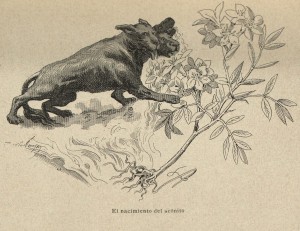
Aconitum also known as wolfsbane is a particularly poisonous plant that grows mainly in the Northern hemisphere. Apparently it was historically used to kill wolves thus the reference to the plant as wolfsbane. The image above is from La Leyenda de las plantas : mitos, tradiciones, creencias y teorías relativos a los vegetales, which displays the myth about how this poisonous plant was formed according to the Greeks. The accompanying text which is in Spanish appears to state that in Hecate’s garden the foam from the mouth of Cerberus fell on the plant and caused it to become a poisonous.
La Leyenda de las plantas is a book that primarily relates legends, myths, folklore, and traditions regarding plants. There are images throughout the text that illustrate plants in alphabetical order usually according to region and their connection to a specific folklore. The Rose of Bahakavali is presumably an Indian legend related to roses.
de las plantas is a book that primarily relates legends, myths, folklore, and traditions regarding plants. There are images throughout the text that illustrate plants in alphabetical order usually according to region and their connection to a specific folklore. The Rose of Bahakavali is presumably an Indian legend related to roses.
The volume also includes a chapter on animal folklore and in one section the text explains about the legendary animals native to the Americas including the eagle, buffalo, vampire bat, jaguar, caiman, and of course the hippo.

La Leyenda de las plantas : mitos, tradiciones, creencias y teorías relativos a los vegetales / Carlos Mendoza ; obra adornada con preciosos cromotipograbados… del reputado artista Luis Labarta… Barcelona : Establ. Tipolitográfico Editorial de Ramón Molinas, [ca. 1880] can be found in Widener’s collection using Hollis.
Thanks to Alison Harris, Santo Domingo Project Manager for contributing this post.
Posted in Widener Library | Comments Off on Plant-lore for the masses
This post is part of an ongoing series featuring items from the newly acquired Santo Domingo collection.
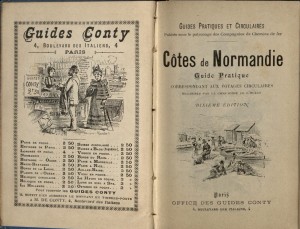 With the advent of smartphones and wifi everywhere, travel guidebooks seem like a thing of the past. Back in the late 19th century though, they might have been the only way to find your way around. The guidebook Côtes de Normandie Guide Pratique, though miniature in size (about the dimensions of an iPhone), is packed full of information and surprisingly large fold out maps. With tiny illustrations to accompany its advice, this guidebook would have been a handy companion for a traveler on the coast of Normandie.
With the advent of smartphones and wifi everywhere, travel guidebooks seem like a thing of the past. Back in the late 19th century though, they might have been the only way to find your way around. The guidebook Côtes de Normandie Guide Pratique, though miniature in size (about the dimensions of an iPhone), is packed full of information and surprisingly large fold out maps. With tiny illustrations to accompany its advice, this guidebook would have been a handy companion for a traveler on the coast of Normandie.


 The first section of the book is organized into a step by step guide of what to do for a 20 day vacation in Normandie, with different suggestions for every day. Also included are sections on hotels, prices, places to eat and advice for how to interact with the people and customs of the area. After the more general information at the beginning of the book, it is split into sections for each town in the area, with general demographic information, climate, and more suggestions specific to each location. There are activities for all types of people, from casinos to outdoor excursions, so that any traveler would find something to do.
The first section of the book is organized into a step by step guide of what to do for a 20 day vacation in Normandie, with different suggestions for every day. Also included are sections on hotels, prices, places to eat and advice for how to interact with the people and customs of the area. After the more general information at the beginning of the book, it is split into sections for each town in the area, with general demographic information, climate, and more suggestions specific to each location. There are activities for all types of people, from casinos to outdoor excursions, so that any traveler would find something to do.
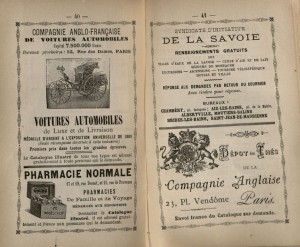
One other interesting addition to this guidebook is the advertising section in the back. Included are typical guidebook ads such as hotels, transportation and restaurants. However, there are also more unusual ads for that type of book like grey-poupon mustard and furniture stores. This small guidebook encompasses everything and acts as a great window into late 19th century tourism.
Côtes de Normandie : Guide pratique correspondant aux voyages circulaires organisés par la compagnie de l’ouest / Paris : Office des Guides Conty, [1895?] is available in Widener Library’s collection.
Thanks to Emma Clement, Santo Domingo Library Assistant, for contributing this post.
Posted in Uncategorized | Comments Off on A Vacation in Normandie
 Although at first glance London Walkabout by Andrew Collins looks like a typical pamphlet for a tourist it actually is much more unusual. Subtitled “Your guide to discovering the myths and legends of ten mystical sties in and around the City of London, accessible in one easy walkabout,” this pamphlet promises a whole lot more than a standard tour. The ten sites include: the Tower of London, the London Stone, the Temple of Mithras, St. Paul’s Cathedral, Ludgate Hill, the Church of St. Martin’s-within-Ludgate, St. Bride’s Church Fleet St., the Church of St. Dunstan’s-in-the-West Fleet St., the Temple Church and St. Clement Danes Aldwych.
Although at first glance London Walkabout by Andrew Collins looks like a typical pamphlet for a tourist it actually is much more unusual. Subtitled “Your guide to discovering the myths and legends of ten mystical sties in and around the City of London, accessible in one easy walkabout,” this pamphlet promises a whole lot more than a standard tour. The ten sites include: the Tower of London, the London Stone, the Temple of Mithras, St. Paul’s Cathedral, Ludgate Hill, the Church of St. Martin’s-within-Ludgate, St. Bride’s Church Fleet St., the Church of St. Dunstan’s-in-the-West Fleet St., the Temple Church and St. Clement Danes Aldwych.

















































 This post is part of an ongoing series featuring items from the
This post is part of an ongoing series featuring items from the 










